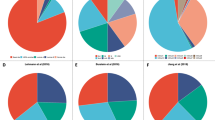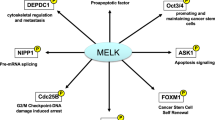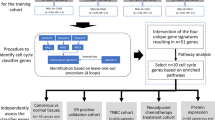Abstract
The recent completion of the human genome sequence has raised great hopes for the discovery of new breast cancer therapies based on newly-discovered genes linked to breast cancer development and progression. Here we describe breast cancer therapies that have emerged from gene-based scientific efforts over the past 20 years and that are now approved for clinical testing or treatment.
This is a preview of subscription content, access via your institution
Access options
Subscribe to this journal
Receive 12 print issues and online access
$209.00 per year
only $17.42 per issue
Buy this article
- Purchase on Springer Link
- Instant access to full article PDF
Prices may be subject to local taxes which are calculated during checkout

Steve Horwitz
Similar content being viewed by others
References
McPherson, K., Steel, C.M. & Dixon, J.M. ABC of breast diseases. Breast cancer epidemiology, risk factors, and genetics. Br. Med. J. 321, 624–628 (2000).
Greenlee, R.T., Murray, T., Bolden, S. & Wingo, P.A. Cancer statistics, 2000. CA Cancer J. Clin. 50, 7–33 (2000).
Saphner, T., Tormey, D.C. & Gray, R. Annual hazard rates of recurrence for breast cancer after primary therapy. J. Clin. Oncol. 14, 2738–2746 (1996).
Hortobagyi, G.N. Developments in chemotherapy of breast cancer. Cancer 88, 3073–3079 (2000).
Carter, S.K. Single and combination nonhormonal chemotherapy in breast cancer. Cancer 30, 1543–1555 (1972).
Fossati, R, et al. Cytotoxic and hormonal treatment for metastatic breast cancer: a systematic review of published randomized trials involving 31,510 women. J. Clin. Oncol. 16, 3439–3460 (1998).
Lanni, J.S., Lowe, S.W., Licitra, E.J., Liu, J.O. & Jacks, T. p53-independent apoptosis induced by paclitaxel through an indirect mechanism. Proc. Natl. Acad. Sci. USA 94, 9679–9683 (1997).
Peto, J. & Mack, T.M. High constant incidence in twins and other relatives of women with breast cancer Nature Genet. 26, 411–414 (2000).
Hortobagyi, G. Adjuvant therapy for breast cancer. Annu. Rev. Med. 51, 377–392 (2000).
Ullrich, A. et al. Human epidermal growth factor receptor cDNA sequence and aberrant expression of the amplified gene in A431 epidermoid carcinoma cells. Nature 309, 418–425 (1984).
Harari, D. & Yarden, Y. Molecular mechanisms underlying ErbB2/HER2 action in breast cancer. Oncogene 19, 6102–6114 (2000).
Hong, W.K. & Ullrich A.U. The role of EGFR in solid tumors and implication for therapy. Oncol. Biotherapeutics 1, 1–30 (2000).
Cardiello, F. et al. Antitumor effect and potentiation of cytotoxic drugs activity in human cancer cells by ZD-1839 (Iressa), an epidermal growth factor receptor-selective tyrosine kinase inhibitor. Clin. Cancer Res. 6, 2053–2063 (2000).
Coussens, L. et al. Tyrosine kinase receptor with extensive homology to EGF receptor shares chromosomal location with neu oncogene. Science 230, 1132–1139 (1985).
Slamon, D.J. et al. Human breast cancer: correlation of relapse and survival with amplification of the HER-2/neu oncogene. Science 235, 177–182 (1987).
Baselga, J. Clinical trials of Herceptin (trastuzumab). Eur. J. Cancer 37, S18–24 (2001).
Slamon, D.J. et al. Use of chemotherapy plus a monoclonal antibody against HER2 for metastatic breast cancer that overexpresses HER2. N. Engl. J. Med. 344, 783–792 (2001)
Pietras, R.J. et al. Monoclonal antibody to HER-2/neureceptor modulates repair of radiation-induced DNA damage and enhances radiosensitivity of human breast cancer cells overexpressing this oncogene. Cancer Res. 59, 1347–1355 (1999).
Kurokawa, H. et al. Inhibition of HER2/neu (erbB-2) and mitogen-activated protein kinases enhances tamoxifen action against HER2-overexpressing, tamoxifen-resistant breast cancer cells. Cancer Res. 60, 5887–5894 (2000).
Lee, R.J. et al. Cyclin D1 is required for transformation by activated Neu and is induced through an E2F-dependent signaling pathway. Mol. Cell Biol. 20, 672–683 (2000).
Pestell, R.G. et al. The cyclins and cyclin-dependent kinase inhibitors in hormonal regulation of proliferation and differentiation. Endocrine Rev. 20, 501–534 (1999).
Sausville, E.A., Johnson, J., Alley, M., Zaharevitz, D. & Senderowicz, A.M. Inhibition of CDKs as a therapeutic modality. Ann. NY Acad. Sci. 910, 207–221 (2000).
Senderowicz, A.M. & Sausville, E.A. Preclinical and clinical development of cyclin-dependent kinase modulators. J. Natl. Cancer. Inst. 92, 376–387 (2000).
Sliwkowski, M.X. et al. Nonclinical studies addressing the mechanism of action of trastuzumab (Herceptin). Semin. Oncol. 26, 60–70 (1999).
Mazumdar, A. et al. Transcriptional repression of oestrogen receptor by metastasis-associated protein 1 corepressor. Nature Cell Biol. 3, 30–37 (2001).
Yang, X. et al. Transcriptional activation of estrogen receptor alpha in human breast cancer cells by histone deacetylase inhibition. Cancer Res. 60, 6890–6894 (2000).
Richon, V.M., Sandhoff, T.W., Rifkind, R.A. & Marks, P.A. Histone deacetylase inhibitor selectively induces p21WAF1 expression and gene-associated histone acetylation. Proc. Natl. Acad. Sci. USA 97, 10014–10019 (2000).
Huang, L. & Pardee, A.B. Suberoylanilide hydroxamic acid as a potential therapeutic agent for human breast cancer treatment. Mol. Med. 6, 849–866 (2000).
Gayther, S.A. et al. Mutations truncating the EP300 acetylase in human cancers. Mutations truncating the EP300 acetylase in human cancers. Nature Genet. 24, 300–303 (2000).
Xing, X. et al. The ets protein PEA3 suppresses HER-2/neu overexpression and inhibits tumorigenesis. Nature Med. 6, 189–195 (2000).
Tazebay, U.H. et al. The mammary gland iodide transporter is expressed during lactation and in breast cancer. Nature Med. 6, 871–878 (2000).
Heffelfinger, S.C., Miller, M.A., Yassin, R. & Gear, R. Angiogenic growth factors in preinvasive breast disease. Clin Cancer Res. 5, 2867–2876 (1999).
Saaristo, A., Karpanen, T. & Alitalo, K. Mechanisms of angiogenesis and their use in the inhibition of tumor growth and metastasis. Oncogene 19, 6122–6129 (2000).
Boehm, T., Folkman, J., Browder, T. & O'Reilly, M.S. Antiangiogenic therapy of experimental cancer does not induce acquired drug resistance. Nature 390, 404–407 (1997).
Kerbel, R.S. Tumor angiogenesis: past, present and the near future. Carcinogenesis 21, 505–515 (2000).
Millauer, B., Shawver, L.K., Plate, K.H., Risau, W. & Ullrich, A. Glioblastoma growth inhibited in vivo by a dominant-negative Flk-1 mutant. Nature 367, 576–579 (1994).
Fong, T.A. et al. SU5416 is a potent and selective inhibitor of the vascular endothelial growth factor receptor (Flk-1/KDR) that inhibits tyrosine kinase catalysis, tumor vascularization, and growth of multiple tumor types. Cancer Res. 59, 99–106 (1999).
Fisher, B. et al. Tamoxifen for prevention of breast cancer: report of the National Surgical Adjuvant Breast and Bowel Project P-1 Study. J. Natl. Cancer Inst. 90, 1371–1388 (1998).
Gail, M.H. et al. Weighing the risks and benefits of tamoxifen treatment for preventing breast cancer. J. Natl. Cancer Inst. 91, 1829–1846 (1999).
Rosenbaum Smith, S.M. & Osborne, M.P. Breast cancer chemoprevention Am. J. Surg. 180, 249–251 (2000).
Torrisi, R. & Decensi, A. Fenretinide and cancer prevention. Curr. Oncol. Rep. 2, 263–270 (2000).
Yang, L.M., Tin- U C., Wu K. & Brown, P. Role of retinoid receptor in the prevention and treatment of breast cancer. J. Mammary Gland Biol. Neoplasia 4, 377–388 (1999).
Schiff, R. et al. Oxidative stress and AP-1 activity in tamoxifen-resistant breast tumors in vivo. J. Natl. Cancer Inst. 92, 1926–1934 (2000).
Harris, R.E., Alshafie, G.A, Abou-Issa, H. & Seibert, K. Chemoprevention of breast cancer in rats by celecoxib, a cyclooxygenase 2 inhibitor. Cancer Res. 60, 2101–2113 (2000).
Torrance, C.J. et al. Combinatorial chemoprevention of intestinal neoplasia using an NSAID and an EGFR-kinase inhibitor. Nature Med. 6, 1024–1028 (2000).
Vadlamui, R. et al. Regulation of cyclooxygenase-2 pathway by HER2 receptor. Oncogene 18, 305–314 (1999).
Hynes, N.E. & Stern, D.F. The biology of erbB-2/neu/HER-2 and its role in cancer. Biochim. Biophys. Acta 119, 165–184 (1994).
Perou, C.M. et al. Molecular portraits of human breast tumours. Nature 406, 747–752 (2000).
Alizadeh, A.A. et al. Distinct types of diffuse large B-cell lymphoma identified by gene expression profiling. Nature 403, 503–511 (2000).
Houston, S.J. et al. Overexpression of c-erbB2 is an independent marker of resistance to endocrine therapy in advanced breast cancer. Br. J. Cancer. 79, 1220–1226 (1999).
Sjogren, S., Inganas, M., Lindgren, A., Holmberg, L. & Bergh, J. Prognostic and predictive value of c-erbB-2 overexpression in primary breast cancer, alone and in combination with other prognostic markers. J. Clin. Oncol. 16, 462–469 (1998).
Archer, S.G. et al. Expression of ras p21, p53 and c-erbB-2 in advanced breast cancer and response to first line hormonal therapy. Br. J. Cancer 72, 1259–1266 (1995).
Berns, E.M. et al. Oncogene amplification and prognosis in breast cancer: relationship with systemic treatment. Gene 159, 11–18 (1995).
Leitzel, K. et al. Elevated serum c-erbB-2 antigen levels and decreased response to hormone therapy of breast cancer. J. Clin. Oncol. 13, 1129–1135 (1995).
Nicholson, R.I. et al. Epidermal growth factor receptor expression in breast cancer: association with response to endocrine therapy. Breast Cancer Res. Treat. 29, 117–25 (1994).
Borg, A. et al. ERBB2 amplification is associated with tamoxifen resistance in steroid-receptor positive breast cancer. Cancer Lett. 81, 137–144 (1994).
Wright, C. et al. Relationship between c-erbB-2 protein product expression and response to endocrine therapy in advanced breast cancer. Br. J. Cancer 65, 118–121 (1992).
Jarvinen, T.A., Holli, K., Kuukasjarvi, T. & Isola, J.J. Predictive value of topoisomerase IIα and other prognostic factors for epirubicin chemotherapy in advanced breast cancer. Br. J. Cancer 77, 2267–2273 (1998).
Rozan, S. et al. No significant predictive value of c-erbB-2 or p53 expression regarding sensitivity to primary chemotherapy or radiotherapy in breast cancer. Int. J. Cancer 79, 27–33 (1998).
Paik, S. et al., erbB-2 and response to doxorubicin in patients with axillary lymph node-positive, hormone receptor-negative breast cancer. J. Natl. Cancer Inst. 90, 1361–1370 (1998).
Jacquemier, J. et al. Breast cancer response to adjuvant chemotherapy in correlation with erbB2 and p53 expression. Anticancer Res. 14, 2773–2778 (1994).
Allred, D.C. et al. Overexpression of HER-2/neu and its relationship with other prognostic factors change during the progression of in situ to invasive breast cancer. Hum. Pathol. 23, 974–979 (1992).
Gusterson, B.A. et al. Prognostic importance of c-erbB-2 expression in breast cancer. International (Ludwig) Breast Cancer Study Group. J. Clin. Oncol 10, 1049–1056 (1992).
Acknowledgements
A.U. is an inventor of patents that cover anti-HER2 antibody development (Herceptin) and anti-VEGFR 2 drugs. He has no financial interest in Genentech. He is a scientific advisor to Pharmacia Corporation on the development of anti-angiogenesis drugs SU5416 and SU6668.
Author information
Authors and Affiliations
Rights and permissions
About this article
Cite this article
Bange, J., Zwick, E. & Ullrich, A. Molecular targets for breast cancer therapy and prevention. Nat Med 7, 548–552 (2001). https://doi.org/10.1038/87872
Issue Date:
DOI: https://doi.org/10.1038/87872
This article is cited by
-
10,11-dehydrocurvularin exerts antitumor effect against human breast cancer by suppressing STAT3 activation
Acta Pharmacologica Sinica (2021)
-
Selective and predicable amine conjugation sites by kinetic characterization under excess reagents
Scientific Reports (2021)
-
Investigating the potential of tetrahydropyridinyl chalcones as useful agents against breast carcinoma: An in vitro and in vivo study
Research on Chemical Intermediates (2018)
-
Inducing Polyclonal Eag1-Specific Antibodies by Vaccination with a Linear Epitope Immunogen and Its Relation to Breast Tumorigenesis
Pathology & Oncology Research (2017)
-
The role of Plk3 in oncogenesis
Oncogene (2016)



